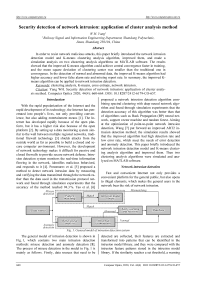Security detection of network intrusion: application of cluster analysis method
Автор: Yang Wenhu
Журнал: Компьютерная оптика @computer-optics
Рубрика: Численные методы и анализ данных
Статья в выпуске: 4 т.44, 2020 года.
Бесплатный доступ
In order to resist network malicious attacks, this paper briefly introduced the network intrusion detection model and K-means clustering analysis algorithm, improved them, and made a simulation analysis on two clustering analysis algorithms on MATLAB software. The results showed that the improved K-means algorithm could achieve central convergence faster in training, and the mean square deviation of clustering center was smaller than the traditional one in convergence. In the detection of normal and abnormal data, the improved K-means algorithm had higher accuracy and lower false alarm rate and missing report rate. In summary, the improved K-means algorithm can be applied to network intrusion detection.
Clustering analysis, k-means, cross entropy, network intrusion
Короткий адрес: https://sciup.org/140250035
IDR: 140250035 | DOI: 10.18287/2412-6179-CO-657
Список литературы Security detection of network intrusion: application of cluster analysis method
- Keegan N, Ji SY, Chaudhary A, Concolato C, Yu B, Jeong DH. A survey of cloud-based network intrusion detection analysis. Human-centric Computing and Information Sciences 2016; 6(1): 19.
- Qiao L, Ryan M. A hybrid approach for supply chain analysis: An application of network and cluster analysis. Incose International Symposium 2017; 27(1): 746-762.
- He ZY. Research on network intrusion detection based on data mining technology. Appl Mech Mater 2015; 713-715: 2081-2084.
- Ganesh S, Ramar K. A cluster based intrusion detection system for homogeneous and heterogeneous mobile ad hoc network. J Comput Theor Nanosci 2017; 14(9): 4249-4254.
- Ponomarev S, Atkison T. Industrial control system network intrusion detection by telemetry analysis. IEEE Trans Dependable Secure Comput 2016; 13(2): 252-260.
- Ma T, Wang F, Cheng J, Yu Y, Chen X. A hybrid spectral clustering and deep neural network ensemble algorithm for intrusion detection in sensor networks. Sensors 2016; 16(10): 1701.
- Wang X. Compulsory coverage network intrusion detection algorithm based on rough set theory. J Comput Theor Nanosci 2016; 13(12): 9480-9483.
- Vahid S, Ahmadzadeh M. KCMC: A hybrid learning approach for network intrusion detection using K-means clustering and multiple classifiers. Int J Comput Appl 2015; 124(9): 18-23.
- Ravale U, Marathe N, Padiya P. Feature selection based on hybrid anomaly intrusion detection system using K Means and RBF kernel function. Procedia Comput Sci 2015; 45(39): 428-435.
- Verma A, Ranga V. Statistical analysis of CIDDS-001 dataset for network intrusion detection systems using distance-based machine learning. Procedia Comput Sci 2018; 125: 709-716.
- Kang SH, Kim KJ. A feature selection approach to find optimal feature subsets for the network intrusion detection system. Cluster Comput 2016; 19(1): 1-9.
- Hao X, Zhang X. Research on abnormal detection based on improved combination of k-means and SVDD. IOP Conf Ser: Earth Environ Sci 2018; 114: 012014.
- Laftah Alyasee W, Ali Othman Z, Ahmad Nazri MZ. Hybrid modified K-Means with C4.5 for intrusion detection systems in multiagent systems. Sci World J 2015; 2015(2): 294761.
- Zhang Y, Wang K, Gao M, Ouyang ZY, Chen SG. LKM: A LDA-based K-means clustering algorithm for data analysis of intrusion detection in mobile sensor networks. Int J Distrib Sens Netw 2015; 2015(2): 7.
- Elssied NOF, Ibrahim O, Osman AH. Enhancement of spam detection mechanism based on hybrid k-mean clustering and support vector. Soft Comput 2015, 19(11): 3237-3248.


